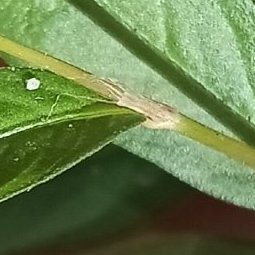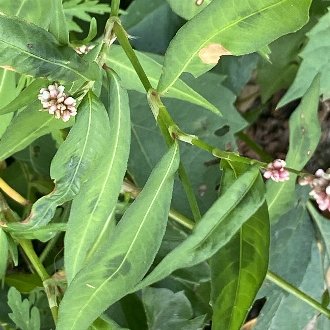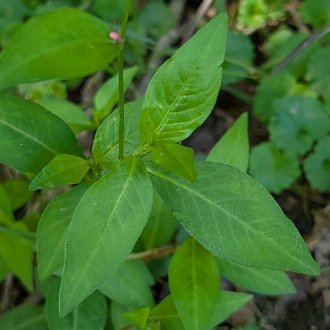Spotted Ladysthumb vs Low Smartweed
This guide is under construction and has not been published yet. It may have errors. When in doubt, double-check other sources for definitive ID.These two smartweeds (Persicaria sp.) are frequently confused and are among the most common weedy smartweeds in gardens. Both are introduced and often invasive. Although they are usually easily told apart, each can also be confused with numerous other species.
Spotted Ladysthumb (Persicaria maculosa) | Low Smartweed (Persicaria longiseta) |
An annual native to east Asia, widely introduced in North America where it is common in suburban gardens and disturbed urban habitats, and occasional in more intact wild ecosystems. | |
Bristles at the margins of the ocreae (sheaths enclosing the stem where each leaf meets the stem) are shorter, usually 0.2-1.3mm long, rarely to 2mm. Bristles are less conspicuous and are often harder to see. Photo © Senna Bryce Robeson, CC BY 4.0. | Bristles at the margins of the ocreae are longer: usually 1-4mm, rarely as short as 0.5mm or as long as 6mm. Bristles are usually easier to see. Photo © Steven Joyner, CC BY 4.0. |
Leaves often have a dark blotch on their upper surface. When present, the blotch is more likely to be bolder and darker in color. Photo © Sandy Wolkenberg, CC BY 4.0. | Leaves usually lack a dark blotch on their upper surface, or have only a very faint or subtle, barely-visible blotch. Photo © Conway Hawn, CC BY 4.0. |
References & External Resources
These short lists show only links helpful for ID. For a complete list of references and resources also covering other aspects of ecology, visit the links section of the full article on each plant, which is the first entry here.






